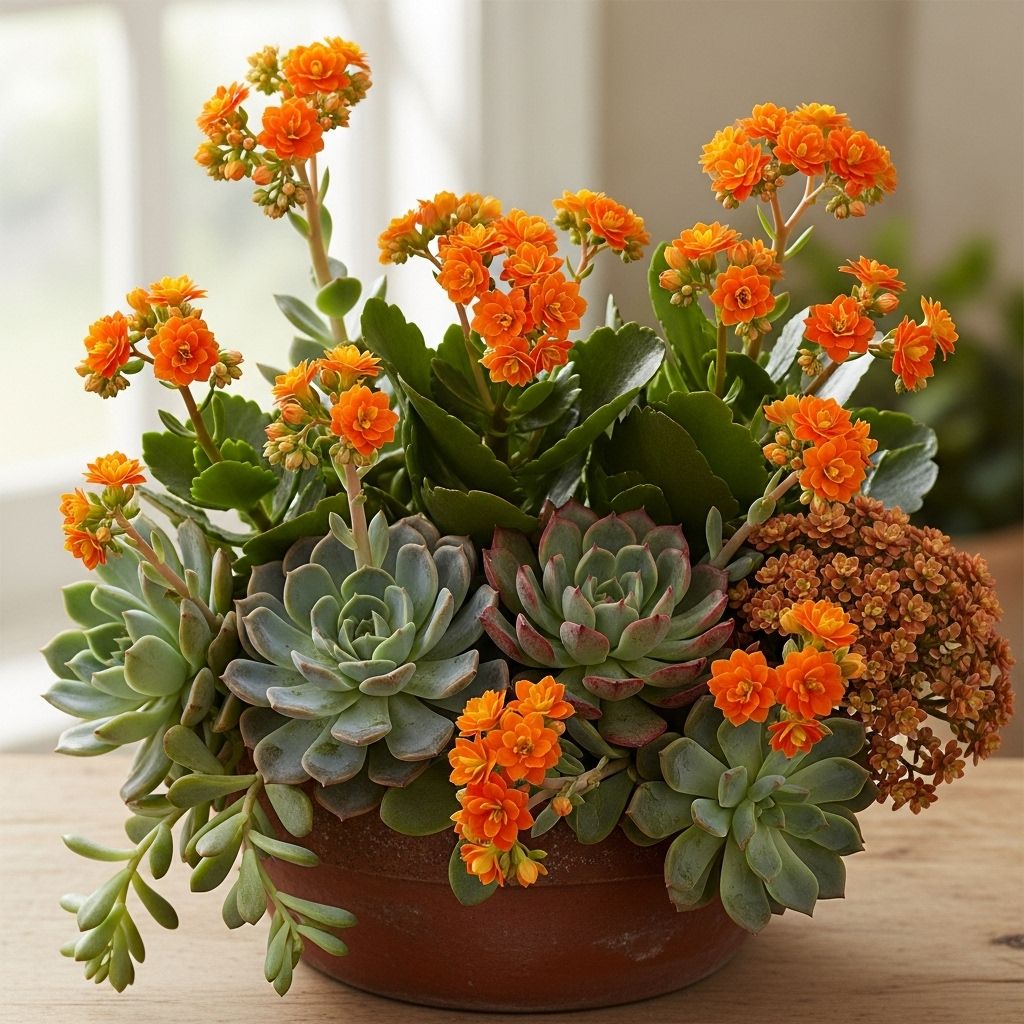Succulents With Orange Flowers: 13 Varieties For Vibrant Spaces
Discover vibrant orange-flowering succulents to brighten your indoor or outdoor garden spaces

Image: HearthJunction Design Team
Orange is an energetic color that brings warmth, happiness, and vibrance to any space. The rich hue evokes images of tangerine zest and the warm glow of candlelight, making it a fabulous choice for enlivening gardens and floral arrangements. If you’re looking to add some visual interest to your succulent collection, orange-flowering varieties offer the perfect combination of low-maintenance care and stunning blooms.
Succulents with orange flowers are particularly special, offering a striking contrast against their typically green, blue, or purple foliage. These plants not only provide the water-wise benefits that all succulents are known for but also deliver spectacular blooms that can transform an ordinary garden into something extraordinary.
Whether you’re an experienced succulent enthusiast or just beginning your plant parenting journey, these orange-flowering varieties deserve a spot in your collection. Let’s explore 13 beautiful succulents and cacti that produce vibrant orange blooms, perfect for brightening both indoor and outdoor spaces.
Orange Crown Cactus
The Orange Crown Cactus (Rebutia muscula) is a small, spherical cactus native to Bolivia that produces abundant orange-red flowers in spring. Despite its spiny exterior, this cactus is known for its spectacular blooming display that can sometimes completely obscure the plant itself.
What makes the Orange Crown Cactus particularly appealing is its compact size, rarely growing larger than 2-3 inches in diameter. This makes it perfect for small spaces, windowsills, or as part of a larger cactus arrangement. The flowers emerge from the sides of the cactus, creating a crown-like appearance that gives this plant its common name.
For the best blooming results, provide this cactus with:
- Bright, indirect light with some morning sun
- Well-draining cactus soil mix
- Infrequent watering—allow the soil to completely dry between waterings
- Protection from frost, as this species is not cold-hardy
Orange Flaming Katy
The Orange Flaming Katy (Kalanchoe blossfeldiana) is one of the most popular flowering succulents available, and for good reason. This beautiful succulent features large, waxy, bright green leaves that provide the perfect backdrop for clusters of tiny, vibrant orange flowers arranged in a rosette formation.
Native to Madagascar, the Orange Flaming Katy has been cultivated worldwide for its striking blooms and ease of care. It’s particularly popular as a gift plant during the holiday season, bringing cheer to any sunny window with its long-lasting flowers that can bloom for weeks or even months.
To encourage more abundant flowering:
- Regularly deadhead spent blooms to promote new flower production
- Provide bright, indirect light—too much direct sun can scorch the leaves
- Water only when the top inch of soil feels dry
- Feed with a diluted succulent fertilizer during the growing season
With proper care, the Orange Flaming Katy can continue to bloom during seasons beyond its typical winter-to-spring flowering period, making it a versatile addition to your succulent collection.
Orange Snowball
The Orange Snowball (Rebutia heliosa) is a charming, small cactus native to the mountainous regions of Bolivia. Despite its name suggesting a cold-weather plant, this succulent actually produces warm, orange-red flowers that create a stunning contrast against its green, tubercled body.
What makes the Orange Snowball special is its clustering growth habit, eventually forming a group of small, round cacti that can create quite a spectacle when in bloom. The flowers emerge from the sides of the plant and can be so numerous that they nearly hide the cactus beneath.
For optimal growth and flowering:
- Place in bright light with some protection from the hottest afternoon sun
- Plant in well-draining cactus soil
- Water sparingly, allowing the soil to dry completely between waterings
- Provide cooler temperatures in winter to encourage spring blooming
The Orange Snowball is an excellent choice for collectors with limited space, as it remains relatively small even at maturity.
Prickly Pear
The Prickly Pear cactus (Opuntia) is perhaps one of the most recognizable cacti in the world, with its distinctive paddle-shaped segments and colorful fruits. While many varieties produce yellow flowers, several species and cultivars offer stunning orange blooms that add a warm glow to any garden landscape.
Unlike many other cacti in this list, Prickly Pear varieties can grow quite large, making them better suited for outdoor gardens or spacious indoor environments. Their flowers typically appear along the edges of the pads in late spring to early summer, followed by edible fruits that range in color from green to purple-red.
To successfully grow Prickly Pear cacti:
- Plant in full sun for the best growth and flowering
- Use extremely well-draining soil—consider adding extra perlite or pumice
- Water deeply but infrequently, allowing the soil to dry out completely between waterings
- Handle with care or use tongs when planting or maintaining, as the tiny glochids (hair-like spines) can be irritating to skin
Prickly Pear cacti are exceptionally drought-tolerant, making them perfect for xeriscape gardens or areas prone to water restrictions.
Red Echeveria
Despite its name, the Red Echeveria (Echeveria ‘Firelight’) often produces orange to coral-colored flowers that rise above its rosette of fleshy leaves on tall, arching stems. This Mexican native belongs to the popular Echeveria genus, known for their attractive rosette form and ease of propagation.
The Red Echeveria features leaves that can take on reddish-orange hues when exposed to bright light, creating a beautiful complement to its orange flower stalks. The bell-shaped flowers typically bloom in late spring to summer, attracting pollinators like hummingbirds and butterflies.
For the best color and flowering:
- Provide plenty of bright light, including some direct morning sun
- Plant in well-draining succulent soil
- Allow the soil to dry completely between waterings
- Protect from frost, as most Echeveria varieties are not cold-hardy
Red Echeveria makes an excellent container specimen, whether as a standalone plant or as part of a mixed succulent arrangement.
Woolly Rose
The Woolly Rose (Echeveria ‘Doris Taylor’) is a charming succulent known for its fuzzy, felt-like leaves that form a compact rosette. While the plant itself is a sight to behold, its orange-red flowers that emerge on tall stalks add another dimension of beauty to this already appealing succulent.
The distinctive fuzzy texture of the Woolly Rose comes from the tiny hairs (trichomes) that cover its leaves, giving it a silvery-green appearance. These hairs serve a practical purpose, helping the plant retain moisture and protect against intense sunlight in its native habitat.
For healthy growth and flowering:
- Position in bright, filtered light—some morning sun is beneficial
- Plant in well-draining soil specifically formulated for succulents
- Water only when the soil is completely dry, and avoid getting water on the fuzzy leaves
- Provide good air circulation to prevent fungal issues
The Woolly Rose’s unique texture and vibrant flowers make it a standout addition to any succulent collection.
Additional Orange-Flowering Succulents
Beyond the varieties mentioned above, there are several other succulents that produce striking orange blooms:
- Aloe vera: While commonly grown for its medicinal properties, many aloe varieties produce orange to red-orange tubular flowers on tall spikes
- Euphorbia milii (Crown of Thorns): This succulent shrub produces clusters of small orange blooms nearly year-round
- Crassula perfoliata (Airplane Plant): Features attractive stacked leaves and clusters of orange tubular flowers
- Sedum adolphii (Golden Sedum): Named for its golden foliage, this sedum produces orange star-shaped flowers
- Delosperma (Ice Plant): Several varieties offer vibrant orange daisy-like flowers that open in sunshine
- Schlumbergera (Christmas Cactus): Some varieties produce orange flowers at the tips of their segmented stems
Care Tips for Orange-Flowering Succulents
While specific care requirements vary by species, most orange-flowering succulents share some common needs:
Light Requirements
Most flowering succulents need bright light to produce blooms. Place them near a south or west-facing window if growing indoors. For outdoor plants, morning sun with afternoon shade is often ideal, especially in hot climates.
Watering Practices
The golden rule for succulent watering is “less is more.” Allow the soil to dry completely between waterings, and reduce watering during dormant periods (typically winter). Always water at the base of the plant to avoid wetting the foliage, which can lead to rot.
Soil and Containers
Well-draining soil is essential for succulent health. Use a commercial cactus/succulent mix or create your own by combining regular potting soil with perlite, pumice, or coarse sand. Ensure containers have drainage holes to prevent water from pooling at the roots.
Temperature Considerations
Most succulents prefer temperatures between 60-80°F (15-27°C). Many can tolerate higher temperatures but may need protection from cold, especially those native to desert or tropical environments. Check the cold hardiness of your specific varieties if planting outdoors.
Encouraging Blooms
To promote flowering in succulents:
- Provide adequate light—flowering requires energy from photosynthesis
- Respect dormancy periods, which often trigger subsequent blooming
- Avoid excessive fertilizing, which can promote foliage growth at the
References
- https://www.epicgardening.com/succulents-with-orange-flowers/
- https://www.epicgardening.com/gardening/ornamental/cacti-succulents/page/6/
- https://www.youtube.com/watch?v=g-scroi4doY
- https://www.pinterest.com/pin/13-different-succulents-cacti-with-orange-flowers-in-2024–478014947966483359/
- https://www.youtube.com/watch?v=gPoyJId48mA
Read full bio of Anjali Sayee












